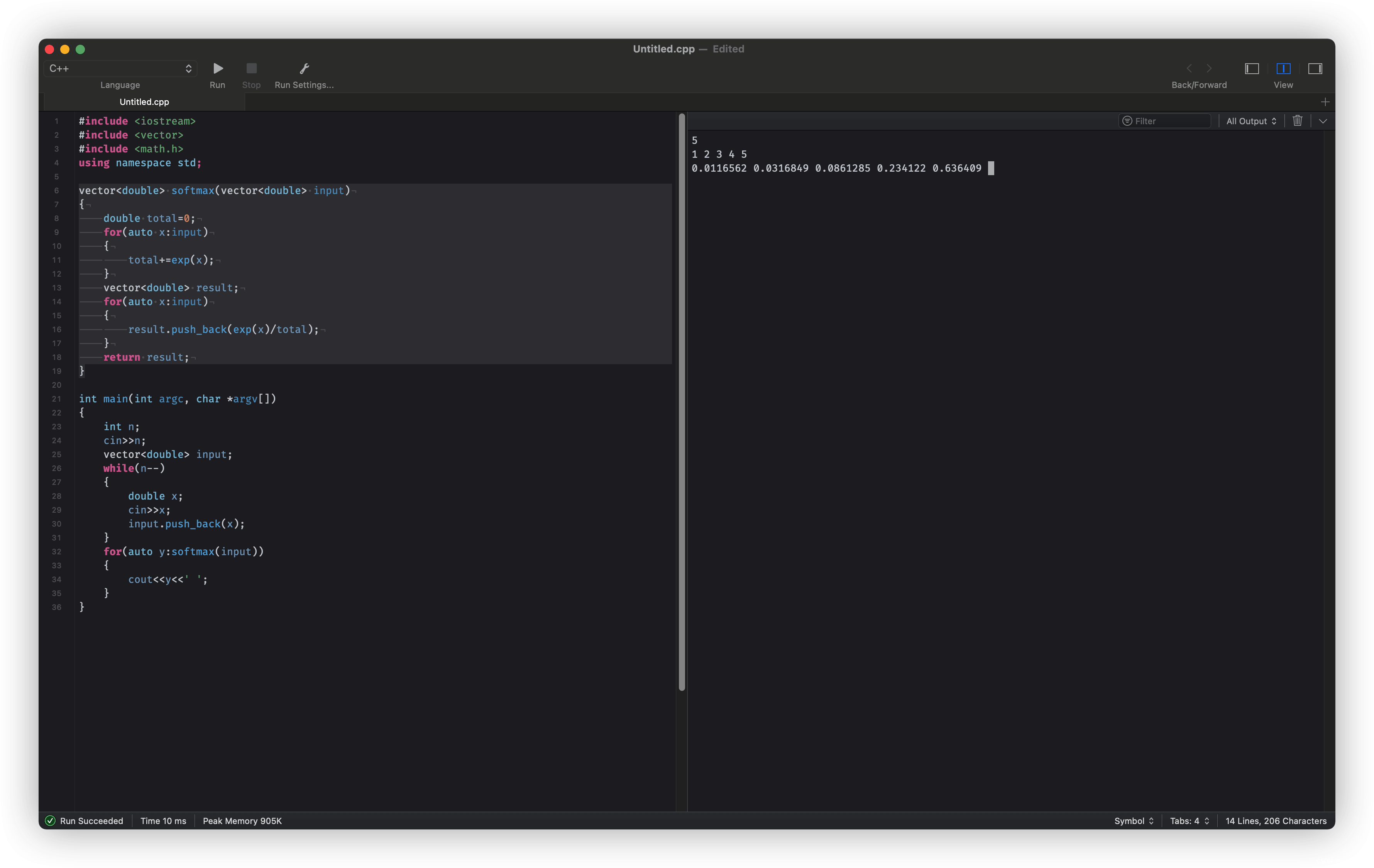C++实现softmax函数的面试经验
目录
- 背景
- 第一次实现
- 实现
- 测试
- test 1
- test 2
- 第二次实现(改进)
- 改进原理
- 实现
- 测试
- test 1
- test 2
- 完整代码
背景
今天面试字节算法岗时被问到的问题,让我用C++实现一个softmax函数。softmax是逻辑回归在多分类问题上的推广。大概的公式如下:

即判断该变量在总体变量中的占比。
第一次实现
实现
我们用vector来封装输入和输出,简单的按公式复现。
vector<double> softmax(vector<double> input)
{
double total=0;
for(auto x:input)
{
total+=exp(x);
}
vector<double> result;
for(auto x:input)
{
result.push_back(exp(x)/total);
}
return result;
}
测试
test 1
- 测试用例1: {1, 2, 3, 4, 5}
- 测试输出1: {0.0116562, 0.0316849, 0.0861285, 0.234122, 0.636409}
经过简单测试是正常的。

test 2
但是这时面试官提出了一个问题,即如果有较大输入变量时会怎么样?
- 测试用例2: {1, 2, 3, 4, 5, 1000}
- 测试输出2: {0, 0, 0, 0, 0, nan}
由于 e^1000已经溢出了双精度浮点(double)所能表示的范围,所以变成了NaN(not a number)。

第二次实现(改进)
改进原理
我们注意观察softmax的公式:

如果我们给上下同时乘以一个很小的数,最后答案的值是不变的。
那我们可以给每一个输入 x i 都减去一个值 a ,防止爆精度。
大致表示如下:

实现
vector<double> softmax(vector<double> input)
{
double total=0;
double MAX=input[0];
for(auto x:input)
{
MAX=max(x,MAX);
}
for(auto x:input)
{
total+=exp(x-MAX);
}
vector<double> result;
for(auto x:input)
{
result.push_back(exp(x-MAX)/total);
}
return result;
}
测试
test 1
- 测试用例1: {1, 2, 3, 4, 5, 1000}
- 测试输出1: {0, 0, 0, 0, 0, 1}

test 2
- 测试用例1: {0, 19260817, 19260817}
- 测试输出1: {0, 0.5, 0.5}

我们发现结果正常了。
完整代码
#include <iostream>
#include <vector>
#include <math.h>
using namespace std;
vector<double> softmax(vector<double> input)
{
double total=0;
double MAX=input[0];
for(auto x:input)
{
MAX=max(x,MAX);
}
for(auto x:input)
{
total+=exp(x-MAX);
}
vector<double> result;
for(auto x:input)
{
result.push_back(exp(x-MAX)/total);
}
return result;
}
int main(int argc, char *argv[])
{
int n;
cin>>n;
vector<double> input;
while(n--)
{
double x;
cin>>x;
input.push_back(x);
}
for(auto y:softmax(input))
{
cout<<y<<' ';
}
}
以上就是C++实现softmax函数的面试经验的详细内容,更多关于C++ softmax函数的资料请关注我们其它相关文章!
赞 (0)

